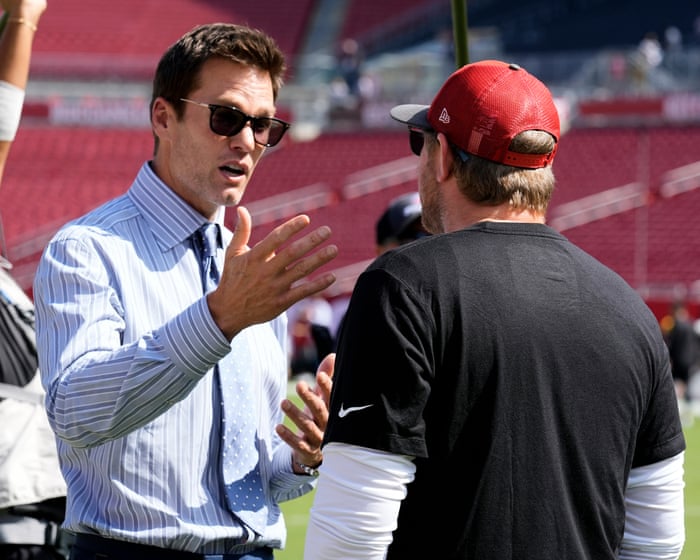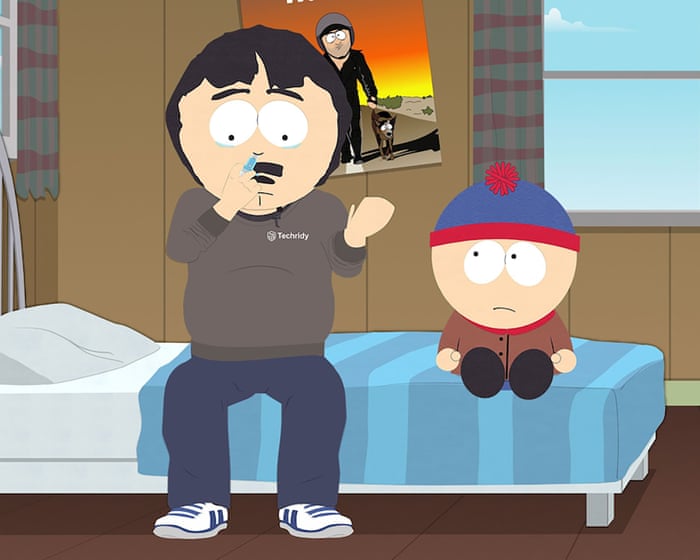It’s time for Tom Brady to make a choice—or better yet, for the NFL to force one. Brady can no longer juggle his dual roles as a minority owner of the Las Vegas Raiders and the lead NFL analyst for Fox. The boundaries are too blurred, and the risk of scandal is unnecessary.
After a rough first year in the broadcast booth, Brady has shown improvement in his second season. During the Giants-Commanders game in week one, he delivered his best performance yet. He sounded relaxed and confident, dropping the forced “whisper-shout” he used last year in favor of a more natural, smooth delivery. He was sharp, seemed to be enjoying himself, and communicated clearly instead of cramming too many thoughts into one sentence. At times, he even offered insightful comments that revealed how the greatest quarterback of all time sees the game.
But just eight days later, Brady stepped back into his role as a team owner. He was in Las Vegas for the Raiders’ Monday Night Football game against the Chargers, and ESPN showed him wearing a headset in the Raiders’ coaching booth. Sideline reporter Peter Schrager mentioned that Raiders offensive coordinator Chip Kelly speaks with Brady two to three times a week to review film and game plans, calling Brady “a luxury for the coaches” given his experience.
The NFL stated that no rules prohibit an owner from sitting in the coaching booth or wearing a headset during a game, clarifying that Brady was there in his capacity as a limited partner. Still, the league posted and then quickly deleted a clip of Brady sitting with the coaching staff. In that moment, the problem was clear—even Brady seemed aware of it, slouching lower in his chair as if trying to disappear. Here was the highest-paid analyst in sports, listening in on coaching decisions and play calls.
Conflicts of interest are common in sports media. Insiders share agents with the players and executives they cover, commentators are friends with coaches and GMs, and broadcasters have relationships from their playing days or careers. Even ESPN’s recent acquisition of NFL Network, with the NFL taking an equity stake in the network, blurs the lines further—now the league’s 32 owners, including Brady, are shareholders of the media company covering them.
Brady’s situation is just the most visible example. He isn’t pretending to be independent; he’s openly a part-owner and key decision-maker for one team while covering the other 31 on Sundays. But it feels wrong, and the fault lies with the NFL, not Brady. He hasn’t broken any rules, and it makes sense for the Raiders to involve the greatest quarterback ever in their game planning. The issue is the league allowing its most prominent broadcast, America’s Game of the Week, to feature someone who attends production meetings with opposing coaches and players, walks the sideline before games, and then sits in a coaching booth with a headset the following week.
A year ago, the NFL worked hard to keep Brady’s roles separate, but that firewall has crumbled. This offseason, the league relaxed its rules, though Brady is still barred from entering another team’s facility.Until game day, Brady cannot attend team practices, but he can join virtual production meetings, where he asks coaches and players questions in the lead-up to broadcasts. The goal was for Fox to sharpen Brady’s broadcasting skills and prevent the league from being embarrassed during one of its most-watched weekly games. But when Brady asks questions in these meetings, who is listening to the answers—Brady the broadcaster or Brady the Raiders owner? Can he separate the two?
Brady has already called games involving the Commanders and Giants, both of whom are on the Raiders’ schedule. The same goes for the Chiefs and Eagles, whom he covered in week two. This week, he’ll be calling Bears-Cowboys, and the Raiders play the Bears the following week.
Production meetings are generally low-stakes. Coaches don’t reveal their game plans; they guard strategic insights and injury updates like state secrets. There’s likely nothing Brady can learn in these meetings that he couldn’t find in public data or by studying the teams on his own.
Still, Brady’s dual roles raise questions about which hat he’s wearing at any moment. Is the Fox audience getting his genuine perspective, or a filtered version from an owner eyeing future signings or hires? Last year, Brady couldn’t criticize officials while working for Fox due to the league’s policy for team owners.
This wouldn’t be such a big deal if Tom Brady weren’t Tom Brady. But he is. There’s an aura of idolatry around him in the NFL that his colleagues don’t enjoy. People want to talk to Brady, to tap into his knowledge and connect with the sport’s most relentless champion. For some, a sideline chat might be their only chance to speak with the seven-time Super Bowl winner.
Brady can’t attend Friday practices, where broadcasters get a behind-the-scenes look at a team. But he can build relationships during the week and chat with players or coaches on the field before heading to the booth. He’s also responsible for hiring and firing with one of the league’s 32 teams. Last season, he called a Lions playoff game while interviewing both of Detroit’s coordinators for his own head coaching vacancy. When Brady talks to someone as a Fox broadcaster, they know he could someday offer them a job.
Tom Brady has stayed highly visible since retiring from play. Perhaps nothing substantial comes from these meetings beyond filler for a three-hour broadcast. But Brady, a fierce competitor and football expert, might pick up on subtle details—a coach’s body language, an impending free agent’s demeanor, or an injury insight not yet public.
And here’s the catch: if Brady didn’t notice or file away such details, he wouldn’t be doing his job—not as a Fox analyst giving viewers inside access, and not as a Raiders owner building a championship team. These two motivations conflict in a way no league should allow.
Sure, if you’re sharing team details with Brady, that’s on you. But what if you’re a soon-to-be free agent aware of the Raiders’ ample cap space? Or a young coach intrigued by the idea of becoming Vegas’ defensive coordinator? Brady’s presence might lead you to reveal something in a five-minute conversation that you wouldn’t share with, say, Cris Collinsworth. It’s a tightrope that teams and players shouldn’t have to walk.
Collinsworth, NBC’s lead analyst, also has a business relationship with all 32 teams as the owner of Pro Football Focus. But there’s no conflict between his off-camera and on-camera work. He doesn’t have a stake in a franchise, wear a team headset, or make personnel decisions. He owns a data and software company.We are a company that sells licenses to any organization willing to purchase them. The boundaries—and any potential conflicts—are clear. His work with PFF complements his role at NBC.
With Brady, the situation is less clear. It would be one thing if he were a silent, passive shareholder, brought out by the Raiders only to help close business deals. But his influence is evident throughout the franchise.
“Tom is the one to lead this organization into the future on the football side, and perhaps turn my failures into successes,” Mark Davis said in September.
Brady led the committee that hired new general manager John Spytek, a former college teammate who also worked with him in Tampa when they won a Super Bowl. Brady also interviewed head coaching candidates for the Raiders, ultimately choosing Pete Carroll. This is not the behavior of an absentee owner. So when Brady puts on a headset in the Raiders’ booth, he is not a detached investor. In the clearest sense, he is part of the football operation. Pretending otherwise would require the kind of willful ignorance only Roger Goodell could muster.
Even if Brady’s side job with Fox provides no tangible benefit to the Raiders, perception matters as much as reality. It creates the impression that Brady is above the rules, eroding fan trust at a time when trust is the league’s most valuable asset.
That trust has already weakened as gambling has become central to the NFL. Betting is no longer just an add-on to the game; at times, it seems like the main event. It’s everywhere: before the game, during the action, in your face, on your feed, on the broadcast ticker, highlighted on RedZone, and featured in every commercial break. The league understands that embracing gambling requires a high level of fan trust, which is why suspensions for players or coaches caught betting on other sports have been so severe.
Thinking the NFL is scripted is an idea your eccentric cousin might bring up at Thanksgiving. But there’s a reason this meme persists, why officiating decisions are heavily scrutinized, and why Brady’s dual roles matter. Once trust begins to crack—when fans start to suspect that insider access could influence competition—the entire foundation trembles.
Allowing Brady to take on both roles is a matter of short-term convenience. The NFL wants to stay in the Brady business, leveraging his star power and the attention he draws into revenue. When he speaks, people listen. Where he goes, others follow. That’s why Fox is paying him $325 million, and Saudi Arabia reportedly paid him $75 million to play flag football.
Being the GOAT has its privileges. But calling games while running a franchise shouldn’t be one of them.
Frequently Asked Questions
Of course Here is a list of FAQs about Tom Bradys move to the Raiders and the NFL rule gap it revealed with clear and concise answers
General Beginner Questions
Q What is the news about Tom Brady and the Raiders
A Tom Brady the retired quarterback is becoming a partowner of the Las Vegas Raiders However he also plans to work closely with the team in a nonofficial coaching role
Q What exactly is the gap in the NFLs rules that was revealed
A The NFL has a strict rule that prevents team owners from also being employed by the team in another role Bradys situation exposed a loophole where an owner could provide coachinglevel advice and access without technically being on the payroll as an employee
Q Why is it a problem for an owner to also be a coach
A The league wants to maintain competitive balance If an owner could also coach they could potentially use their financial power and influence in ways that give their team an unfair advantage bypassing rules meant for coaches and football staff
Q So is Tom Brady officially a coach for the Raiders
A No he is not His official title is a partowner The issue is that he intends to be heavily involved in football operations and player development which blurs the line between an owners duties and a coachs duties
Advanced Detailed Questions
Q What specific rule did this situation challenge
A It challenged the NFLs longstanding policy that prohibits a person from holding both an ownership interest and an employee role with the same club
Q How did the NFL resolve this issue
A The NFLs owners voted to close the loophole They passed a new rule that prohibits anyone with an ownership stake in a team from having a direct operational role in football matters even if they are not a salaried employee
Q What does this new rule mean for Tom Brady specifically
A Bradys ownership purchase was approved but he must now operate strictly as an owner He cannot be in practice or meetings in a coaching capacity have a direct role in game planning or be involved in personnel decisions He is essentially limited to an advisory role from the owners box




